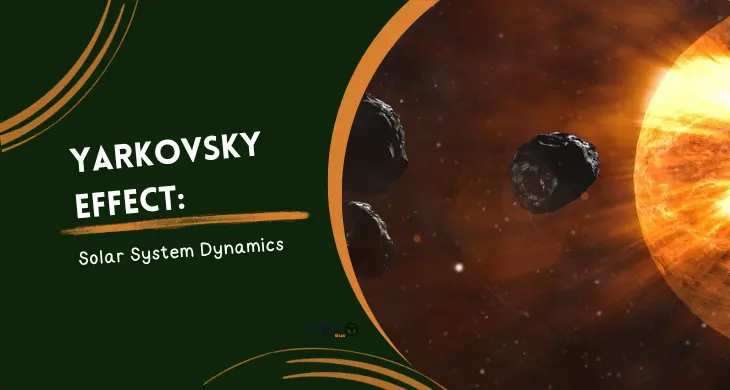The cosmos, with its myriad celestial bodies, is a dynamic arena where forces, both known and mysterious, shape the paths and destinies of objects within it. One such intriguing phenomenon is the Yarkovsky Effect, a subtle but profound force that influences the trajectories of asteroids and other space objects. This blog delves into the Yarkovsky Effect, uncovering its underlying principles, historical significance, and its impact on the evolution of our solar system.
The Yarkovsky Effect Unraveled:
The Yarkovsky Effect, a fascinating and subtle force in the realm of celestial dynamics, is a phenomenon that comes into play when asteroids and other space objects orbit the Sun. It’s essentially a consequence of the way these objects interact with solar radiation. As these celestial bodies rotate, they absorb sunlight and become thermally heated. When they emit this absorbed heat as infrared radiation into space, it generates a small but notable recoil effect. This recoil, in turn, can either accelerate or decelerate the object’s orbital motion, depending on various factors like the object’s shape, rotation, and thermal properties.
In simpler terms, it’s as if these space objects are receiving a gentle push due to the way they absorb and re-emit solar energy. While the effect is subtle, it can significantly impact the paths and trajectories of asteroids, potentially influencing their positions and even collision risks.
The Yarkovsky Effect is named after Ivan Osipovich Yarkovsky, a Russian engineer who initially described it in 1900. Although it remained relatively obscure for some time, it gained more recognition in the mid-20th century when it was revisited and expanded upon by the Russian scientist Georgy Shchapov.
Historical Significance:
The Yarkovsky Effect carries notable historical significance in the fields of astronomy, celestial mechanics, and planetary defense:
- Discovery and Early Exploration: The effect was first described by Russian engineer Ivan Osipovich Yarkovsky in 1900. At that time, it was a relatively obscure concept. Over the years, it gained recognition as scientists began to explore the dynamics of asteroids and their orbits more thoroughly.
- Mid-20th Century Advancements: The Yarkovsky Effect gained prominence in the mid-20th century when Russian scientist Georgy Shchapov expanded upon the concept. His work was instrumental in helping astronomers and researchers understand the intricacies of the effect and its implications for celestial objects in our solar system.
- Planetary Defense: The Yarkovsky Effect plays a vital role in the field of planetary defense. Understanding the orbital dynamics of near-Earth asteroids and their potential collision risks with our planet is essential for safeguarding Earth from impacts. The effect’s influence on asteroid trajectories is a critical factor in assessing the long-term threat posed by these celestial bodies.
- Space Missions: For missions to asteroids and other small solar system bodies, the Yarkovsky Effect must be considered when planning spacecraft trajectories. Engineers and scientists need to account for this subtle force to ensure the success of missions like sample return or deflection attempts.
- Solar System Evolution: This effect also has implications for our understanding of the long-term evolution of the solar system. By influencing the orbits and positions of asteroids, the Yarkovsky Effect contributes to the dynamics of the solar system’s architecture over millions of years.
Implications for Solar System Dynamics:
The Yarkovsky Effect has profound implications for solar system dynamics, contributing to our understanding of how celestial objects move and interact within our cosmic neighborhood. Here are several significant consequences:
- Asteroid Orbits and Movements: The Yarkovsky Effect influences the orbital paths of asteroids. It causes subtle changes in an asteroid’s position over time, which can accumulate and significantly affect its long-term trajectory. Understanding these effects is essential for predicting the future positions of asteroids and their potential risks to Earth.
- Near-Earth Object (NEO) Studies: NEOs, including potentially hazardous asteroids, are a focal point of solar system research. The Yarkovsky Effect is particularly relevant when studying NEOs because it can affect their orbits and positions, making it crucial for assessing their potential impact on Earth.
- Space Exploration and Missions: For spacecraft missions to asteroids, the Yarkovsky Effect must be considered during mission planning. Engineers and scientists need to account for these effects to ensure precise spacecraft trajectories, especially for sample return missions or those aimed at deflecting hazardous asteroids.
- Planetary Defense: Given its influence on the orbits of asteroids, understanding the Yarkovsky Effect is vital for planetary defense. Scientists can use this knowledge to assess the potential threat posed by near-Earth asteroids and develop strategies to mitigate impact risks.
Space Missions and Planetary Defense:
Space missions and planetary defense are two critical areas in which the Yarkovsky Effect plays a significant role. Here’s how this effect impacts both space missions and our strategies for defending Earth from potential asteroid impacts:
Space Missions:
- Trajectory Calculations: When planning space missions to asteroids, understanding the Yarkovsky Effect is crucial. This effect can subtly alter the asteroid’s orbit over time due to variations in its surface heating and cooling. Mission planners must account for these changes to ensure spacecraft reach their target asteroids accurately.
- Sample Return Missions: Many space missions involve sample return from asteroids. The Yarkovsky Effect’s influence on asteroid orbits must be considered during the mission design to ensure that the spacecraft can reach and return safely with the desired samples.
- Orbit Adjustments: Spacecraft may need to make orbit adjustments during their missions. Understanding the Yarkovsky Effect helps mission controllers calculate the necessary maneuvers for precise orbit control.
Planetary Defense:
- Orbit Prediction: The Yarkovsky Effect has implications for near-Earth objects (NEOs), including potentially hazardous asteroids. Accurate orbit prediction is essential for assessing the potential threat posed by NEOs and planning planetary defense strategies. By considering the Yarkovsky Effect, scientists can make more precise predictions about an asteroid’s future path.
- Deflection Strategies: If an asteroid is on a collision course with Earth, understanding its orbit and the Yarkovsky Effect’s influence can inform deflection strategies. This might involve changing the asteroid’s trajectory to avoid an impact. Effective deflection strategies require precise knowledge of an asteroid’s orbit and how it may change over time.
- Early Warning: Early detection and tracking of NEOs are crucial for planetary defense. The Yarkovsky Effect adds an additional layer of complexity to these efforts, highlighting the importance of early warning systems and long-term monitoring of potentially hazardous asteroids.
Yarkovsky Effect and the Solar System’s Past and Future:
The Yarkovsky Effect, a fascinating phenomenon driven by the absorption and emission of solar radiation, has profound implications for the past and future of our solar system. Here’s how this effect has shaped and will continue to influence the dynamics of celestial bodies in our cosmic neighborhood:
Historical Significance:
- Asteroid Families: The Yarkovsky Effect has contributed to the formation of asteroid families in the asteroid belt. Over millions of years, as asteroids’ orbits evolve due to this effect, groups of asteroids with similar orbits, known as families, emerge. These families provide valuable insights into the history and evolution of the solar system.
- Space Weathering: Solar radiation not only influences an asteroid’s orbit but also causes surface alterations through a process known as space weathering. Over time, this effect can modify the appearance and composition of asteroids. By studying these changes, scientists gain a deeper understanding of the solar system’s history.
Implications for Solar System Dynamics:
- Asteroid Orbits: The Yarkovsky Effect subtly alters the orbits of asteroids, and this influence extends to the evolution of near-Earth objects (NEOs). It is a significant factor in calculating the long-term dynamics of these celestial bodies, including their potential to impact Earth.
- Future Predictions: To forecast the future positions of asteroids and NEOs, taking the Yarkovsky Effect into account is essential. This effect introduces a level of uncertainty that must be considered in planetary defense efforts, helping us prepare for possible asteroid impacts and develop deflection strategies if needed.
Space Missions and Planetary Defense:
- Space Exploration: When planning space missions to study or retrieve samples from asteroids, understanding the Yarkovsky Effect is paramount. Mission designers must factor in the long-term changes in an asteroid’s orbit due to this effect to ensure successful missions.
- Planetary Defense: Accurate predictions of an asteroid’s trajectory, including the influence of the Yarkovsky Effect, are crucial for assessing the potential threat of asteroid impacts on Earth. This information guides our efforts in developing early warning systems and potential deflection strategies.
Frequently Asked Questions:
Q1: What is the Yarkovsky Effect, and how does it work?
A1: The Yarkovsky Effect is a force that influences the motion of celestial objects, particularly asteroids, due to the way they absorb and emit solar radiation. As an asteroid rotates, the uneven heating and cooling of its surface create a tiny, but persistent, force that can alter its orbit over time.
Q2: How does the Yarkovsky Effect impact asteroid orbits?
A2: The Yarkovsky Effect causes asteroids to undergo gradual orbital changes. It can push asteroids closer to the Sun or farther away, affecting their positions in the solar system. Over millions of years, this effect can lead to the formation of asteroid families and influence the paths of near-Earth objects.
Q3: Why is the Yarkovsky Effect important for planetary defense?
A3: The Yarkovsky Effect plays a crucial role in understanding the future trajectories of near-Earth objects (NEOs) and potentially hazardous asteroids. By considering this effect, scientists can make more accurate predictions about the paths of these objects and assess the risk of future impacts on Earth.
Q4: Are there any space missions related to the Yarkovsky Effect?
A4: Yes, several space missions have taken the Yarkovsky Effect into account. For example, NASA’s OSIRIS-REx mission to the asteroid Bennu considered this effect when planning its sample return mission. Understanding the Yarkovsky Effect is essential for the success of such missions.
Q5: Can the Yarkovsky Effect be harnessed for space exploration or asteroid deflection?
A5: While the Yarkovsky Effect is relatively weak, it has been considered in mission planning. However, it’s typically a force to account for rather than exploit. For asteroid deflection, other methods, such as kinetic impactors or gravity tractors, are more effective.
Conclusion:
The Yarkovsky Effect is a remarkable and understated force in the dynamics of our solar system. This phenomenon, while subtle, has far-reaching implications for space exploration, planetary defense, and our understanding of the cosmos. It is a testament to the intricate interplay of forces that govern the celestial realm, and its continued study promises to unveil further mysteries of our solar system’s evolution.




